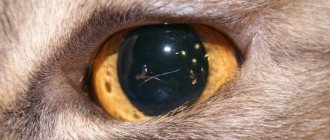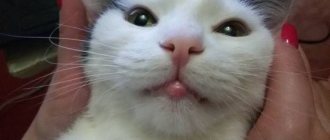8956Administration
Noticing sores on a cat's lips, some owners do not attach much importance to it, hoping that everything will go away on its own. If we are talking about an ordinary wound on the skin or mucous membrane, received while eating or during a fight with another cat, then it will heal really quickly.
Although in these cases it is advisable to show the animal to a veterinarian and be sure to disinfect the damaged area. However, there are situations that are much more serious. These are sores called herpes and Jacobs ulcer (the second name is eosinophilic granuloma).
© shutterstock
The cat has a sore on her lip: Is there viral rhinotracheitis on her face?
Viral rhinotracheitis - herpes in cats, like other viral respiratory infections, is widespread. The disease affects everyone from the cat family; all breeds of cats are affected, regardless of age, with the exception of kittens up to two months of age, which receive antibodies from their mother with milk.
Risk factors for infection:
- Group keeping of animals (shelters, catteries)
- Animals weakened by stress.
- Inadequate feeding.
- Ages from two months to one year and over fourteen years.
The peak of the disease in cats occurs during the cold and rainy seasons (winter, early spring, late autumn). When kept in crowded conditions, the infection takes on the character of a permanent enzootic.
Watch the video: Sore on a cat’s lip - on the face Calicivirus
The source of feline rhinotracheitis are patients and carrier cats. The rhinotracheitis virus can be transmitted to healthy cats through direct contact with sick animals through discharge from the nasal and oral cavity and eyes.
The main route of infection is aerogenic, that is, through the air, which contributes to the rapid spread of the disease.
The most common routes of transmission are food, care items, people in contact with sick cats, and contaminated air. The disease is species-specific and is not dangerous for humans or other animal species.
If the cause of sores on a cat’s lips is viral rhinotracheitis, the clinical picture will be as follows:
- Copious nasal discharge.
- Decreased appetite.
- Lethargy.
- Fever.
- Cough.
- Ulcers on the lips that look like herpetic rashes in humans.
- Increased lacrimation, conjunctivitis.
The course of the disease can be acute, subacute and chronic; in advanced cases, severe pneumonia develops.
Read the article “How to give medicine to a cat?
Tips for ensuring comfort for a cat" - https://strazhchistoty.ru/cleanup/cleancats/kak-dat-lekarstvo-koshke.html
What to do?
The doctor will tell you how to treat your pet, but every owner should know the general recommendations regarding each case that were listed above.
There is no need to start treatment until an accurate diagnosis has been established. Each disease requires an individual method of treatment, and the characteristics of the cat’s body should also be taken into account.
In most cases, when owners contact a veterinarian, the doctor prescribes the medicine Dexamethasone, which is available in the form of ampoules for injections. The active ingredient of the drug has an anti-inflammatory, anti-allergic effect. If the lesion is infectious, antibiotics are prescribed along with Dexamethasone.
Another product that can neutralize the bacterial threat is called Sinulox, which is available in the form of a suspension or tablet form. In case of infection of the mucous membranes of the oral cavity and tongue, this remedy is indispensable. The drug is very effective in the fight against gingivitis. When using medications as prescribed, you must strictly follow the instructions for use.
To avoid the development of recurrent disease, it is necessary to carefully monitor the cat’s oral hygiene.
Swollen lower lip
In case of injury, it is important to remember that bacteria can enter the animal’s body through the wound. Therefore, it is necessary to treat the scratch with an antiseptic as quickly as possible and choose a suitable diet for the pet. It should include only soft food, as well as soups and cereals. No dry food, bones or cartilage.
In case of a burn, if the latter is of electrical origin, the pet must be urgently shown to a veterinarian. If the cat has slightly burned its lip and only slight redness and slight swelling are present as a symptom, then treatment can be carried out at home. To do this, you need to rinse the damaged tissue with clean water at room temperature and cover the area with a sterile cloth.
If the cause of swelling of the lower lip is an eosinophilic granuloma, then it is important to conduct a thorough diagnosis. The fact is that identifying the disease is complicated by its similarity to various fungal and bacterial pathologies. To make a diagnosis, smear cytology is performed, which in granuloma contains too many eosinophils. The medicine is selected after the allergen that caused the disease has been identified.
To treat fungal infections, complex procedures are used that are aimed at both combating the internal causes of pathology and eliminating the external symptoms of the fungus.
For benign tumors, only surgical removal of the tumor will help. Malignant manifestations are very difficult to treat. In this case, surgical removal of the tumor is performed, and radiation therapy is also performed.
It happens that in some areas of the cat's face (on the nose, ears or lips) dark spots ranging from brown to completely black suddenly appear. This can be a serious concern for many owners. However, there is no reason to panic: this is a common occurrence and does not pose a danger to the animal. There is even a special name for it - lentigo.
Lentigo occurs when one skin cell produces more melanin than others adjacent to it. This causes darkening, causing the spot to appear different from the rest of the skin. Lentigo can appear anywhere. However, it is most often seen on the nose, lips and the inside of the ears.
Predisposition to lentigo
Lentigo runs in families and is more common in tabby cats. Age and sun exposure also increase the likelihood of its occurrence. Lentigo almost never occurs in kittens and young cats.
Appearance
Lentigo spots range from light brown to deep black. These may be several small specks or, on the contrary, large spots. The appearance and disappearance of lentigo cannot be predicted.
When to start worrying
If the spot becomes inflamed, swollen, or suddenly begins to grow, you should take your pet to the vet. Such changes may indicate skin cancer and therefore require special attention. If the cat has a light pink nose, any darkening of the skin should be treated with caution and it is advisable to immediately show the pet to a specialist. Light-skinned cats are especially prone to skin conditions and pigmentation.
Now you know that your cat has dark spots, it is not as scary as it might initially seem.
We suggest you read: How to remove red wine from a sofa and remove stains
A cat has a sore on his lip (lower): Diagnosis of viral rhinotracheitis
If you notice the above symptoms in your pet, or at least some of them, you need to show the animal to a veterinarian.
In Moscow, you can contact the veterinary clinics of the network “Your Doctor” or “Bely Klyk”, as well as the Innovative Veterinary Center of the Moscow Veterinary Academy (IVC MBA).
In St. Petersburg, competent specialists will help you at the clinics “Dog and Cat”, “Lucky”, “Your Doctor”.
In Voronezh, we recommend visiting the blades “Eurovet” and “Cat Matroskin”.
The veterinarian will conduct an examination, thermometry, a general blood and urine test, and take swabs from the nasopharynx for analysis using PCR or ELISA to identify the causative agent of rhinotracheitis.
Diagnostic measures
Examination and diagnosis of an animal involves taking blood and urine for examination. When a cat’s lower lip is swollen, turns black or red, and other unpleasant symptoms appear, it is necessary to urgently contact a veterinarian. A specialist will assess the condition of the pet and help determine the reasons for the swelling. If a visual examination fails to establish a diagnosis, then the following manipulations are performed:
- laboratory testing of urine and blood;
- biochemical analysis;
- culture for the presence of bacterial and fungal microflora;
- diagnostics using ultrasound;
- x-rays.
A cat has a sore on his lip: Treatment of viral rhinotracheitis
After confirming the diagnosis, the veterinarian will prescribe the following treatment:
- Complete feeding with soft, semi-liquid food, vegetables and cereals are excluded; in the first days of illness, the animal can be given low-fat meat broths, boiled chopped meat or fish, eggs and dairy products.
- Industrial feeds are given mainly in the form of pates, they should also be heated.
- If the animal completely refuses food, infusion therapy is carried out with Ringer-Locke and Glucose solutions.
- Systemic antiviral therapy (Famciclovir).
- Local treatment of sores with antiseptic solutions (Chlorhexidine, Miramistin) and antiviral ointment Acyclovir.
- Rinsing the nasal and oral cavities with antiseptic solutions.
- Symptomatic therapy: mucolytics for cough (Mukaltin), antipyretics for fever (injections of Analgin with Diphenhydramine).
- For severe conjunctivitis, Decta-2 drops
- Introduction of vitamins: Gamavit, Hemobalance.
- The use of a specific serum (Vitafel).
- If complications develop, antibiotic therapy is prescribed.
- Immunomodulators (Fosprenil, Anandin).
The incidence of infectious rhinotracheitis in cats reaches 50%, mortality is 5-20%. After recovery from the disease, cats may become carriers of the virus.
The duration of the disease is 10-14 days, in some cases the disease drags on for several weeks and is accompanied by a rare cough and periodic runny nose. Cats with ulcerative stomatitis or pneumonia often die.
See how to properly hold your cat during treatment
How to distinguish acne from other pathologies
Dental diseases are very often accompanied by slight swelling of the lip border and oral mucosa. The most common cause of enlargement of the lower lip is gingivitis - inflammation of the gums. The causes of gingivitis are weakened immunity, mucosal injury, and food allergies.
Characteristic symptoms:
- bad breath;
- red border around teeth;
- loss of appetite;
- increased saliva production;
- swelling of the gums and lips.
Older animals or cats whose bodies are weakened by a long-term illness are more likely to experience gingivitis. This disease requires treatment as it can lead to tooth loss.
Gingivitis is treated with medication, using topical agents. As a rule, special gels or ointments with an antibiotic and an anti-inflammatory component are prescribed. Plaque must be cleaned and tartar removed. Additionally, medications are prescribed to enhance immunity.
It is important to be able to distinguish black dots from waste products of blood-sucking parasites and their larvae, as well as from droplets of dried blood that could appear as a result of trauma to the skin. Differentiating one condition from another is quite simple. You need to carefully try to detach the black lump. If it comes off easily from the skin and is dark brown in color, then it is dried blood.
Dried blood on a cat's chin looks like inflammation of the sebaceous glands
It is important to inspect the surface for scratches and small wounds. If the black dot has separated from the skin, but has a dense consistency and is difficult to press, then most likely these are waste products of ticks or fleas. Less commonly, these can be larvae of blood-sucking parasites. Acne is indicated by the inability to separate the blackhead from the skin. At the same time, it is as if soldered into the mouth of the sebaceous gland.
Flea larvae in cats can be confused with blackheads
Prevention of infectious rhinotracheitis
- Timely vaccination of kittens and adult cats (Multifel-3, Quadriket vaccines).
- Avoid contact with stray animals.
- Tray hygiene.
- Regular treatment against ectoparasites.
- Complete and balanced feeding.
- Elimination of stressful situations.
- Do not allow your cat to become hypothermic.
- Do not give the animal cold water.
Read the article “Comb for long-haired cats: Which one to buy?” — https://strazhchistoty.ru/cleanup/cleancats/rascheska-dlya-koshek.html
A cat has an ulcer on her lip: Eosinophilic granuloma complex
If an ulcer on an animal’s lip is an accidental discovery—that is, the cat does not show any symptoms of concern—then, most likely, we are talking about the formation of an eosinophilic granuloma or Jacobs ulcer.
This disease is considered poorly understood, and there are many hypotheses about its causes. Here are the main ones:
- Allergic reaction.
- Sensitization of the animal's body by endo- or ectoparasites.
- Genetic predisposition.
It is also noted that this disease most often affects purebred cats and individuals obtained through inbreeding. Females over 6 years of age are most often affected.
Watch the video: Stomatitis in cats - Symptoms and treatment
Things to remember
When treating or diagnosing Jacobs ulcer, one must remember that this disease often manifests itself as one of the varieties of a large complex of eosinophilic granuloma.
In addition to ulcers, it can “give out”:
- Eosinophilic plaques.
- Eosinophilic granulomas.
- Allergic milliary dermatitis.
Why does the average cat owner need all this information? It just happens that all these lesions are grouped and occur in the same animal. Therefore, cases where Jacobs ulcer has spread to the abdomen are precisely a systemic complex of eosinophilic granuloma.
All diseases in this group respond to the same therapy and are diagnosed in the same way. It’s just that in case of damage to large surfaces of the body, you need to understand that something is seriously wrong with the animal’s immunity. It may be worth suspecting the presence of some kind of autoimmune disease.
A cat has a sore on his lip (on the upper one): Clinical signs and diagnosis
As mentioned above, eosinophilic granuloma at the beginning of the disease does not bother the animal in any way. It usually appears in the middle of the upper lip in the form of a pink, gnawed out spot. Over time, without treatment, it grows up to the nose and into the oral cavity, deepens, becomes inflamed, and the roots of the teeth and gum bones are exposed.
Therefore, if you notice a formation on your cat’s upper lip, we advise you not to delay visiting the veterinary clinic, especially since a number of sources consider this disease to be a precancerous condition.
After examining the animal and collecting anamnesis, the veterinarian will perform a biopsy of the ulcer followed by microscopy of the material taken. The presence of eosinophilic proliferation confirms the diagnosis.
Read the article “How to wash a cat and whether to wash it at all. Almost Hamlet’s question” - https://strazhchistoty.ru/cleanup/cleancats/kak-myt-kota.html
How to diagnose the cause
Treatment will depend on why the swelling occurs. Sometimes the source of the problem can be recognized immediately - for example, if a swollen lip occurs after a wasp or a bee has landed on it, then, without a doubt, the problem is an insect bite. But more often than not, the cause cannot be determined. To find out the diagnosis, you will have to carry out a number of manipulations. First of all, you need to observe the cat to identify other symptoms:
- Dental diseases, in addition to swelling of the lips, are accompanied by: an unpleasant odor from the cat’s mouth;
- redness of the gums;
- increased salivation.
- Allergy: a rash appears on the cat’s skin, the cat tries to scratch the swollen lip, which indicates itching or burning, the swelling is hot to the touch.
- Eosinophilic granuloma: The cat's lips not only become swollen, but also become covered with plaques (similar to herpes). In this case, a swallowing disorder may occur, which subsequently leads to the cat refusing to eat.
- Injuries: the cat does not close its mouth, hides and meows pitifully, which indicates the pain the animal is experiencing. When the lower jaw tilts to the side, the cause is most likely a dislocation or fracture.
- Neoplasms: swelling of the lip develops gradually (first a small red or whitish spot appears, then it thickens and constantly grows). If it is malignant, weeping eczema and bleeding ulcers may occur at the site of the tumor. In addition, the cat has:
- loss of appetite;
- frequent vomiting;
- weakness.
- general blood analysis;
- tissue biopsy (to exclude tumor neoplasms);
- allergy test;
- microscopy (to detect bacterial infection, skin parasites, mycosis).
Visual observation of the animal alone is not enough to establish the exact cause of lip swelling. Veterinarians also use a comprehensive diagnostic method, including:
If dislocations or jaw fractures are suspected, radiography is performed.
A cat has a sore on his lip: Treatment of Jacobs ulcer
Once the diagnosis is made, the veterinarian will prescribe the following treatment:
- Feeding with hypoallergenic food (rice, low-fat cottage cheese, homemade cheese).
- If the cat is accustomed to industrial food, then choose hypoallergenic food from the premium and extra-premium line.
- Fight against fleas and other ectoparasites (Advocate drops, Bars spray), make sure that the drugs do not get on the affected areas.
- Systemic corticosteroids by injection for a course of three weeks (Dexamethasone, Prednisolone).
- Injections or slow infusions of calcium gluconate 10%.
- Antihistamines (Suprastin, Diphenhydramine).
- Vitamin preparations (Gamavit, Hemobalance).
- Allergy test at the end of treatment: intradermal or based on the titer of antibodies in the blood (insignificant for food allergies) followed by hyposensitization.
See what anti-allergy foods you can buy
Salivary gland tumor and cyst
If an animal receives a lip injury and is not provided with timely medical care, it can lead to damage to the salivary glands and the subsequent formation of cysts and tumors. At the same time, thick secretions begin to form in the gland ducts, and the ducts themselves are often covered with food debris. Then fluid begins to accumulate in the ducts, which causes the formation of a cyst.
In this case, swelling often occurs on the lower lip, since the submandibular salivary glands are located adjacent to it. The tumor site is very noticeable and smooth to the touch, has a rounded shape. In some cases, it occurs only on one side, under the tongue, but there are cases of swelling on the walls of the pharynx. Please note that the cyst can become very large and begin to interfere with the cat's swallowing and breathing processes.
If in the described case the cat’s lower lip is swollen, then mandatory surgical intervention is necessary. Namely, to make a puncture in order to remove the substance filling the cyst cavity. If this does not bring any effect, then the salivary gland is surgically removed.
A cat has a ball-shaped sore on her lip: Subcutaneous abscess
Another disease in which the owner can detect a sore on a cat’s lip is a subcutaneous abscess. The lesion will cause anxiety to the pet; the skin at the site of the lesion will be swollen, hot to the touch, and an abscess ball can be palpated underneath it.
If the abscess has already opened on its own, then yellow or white, or in severe cases green, pus will be released from the hole in the skin.
Causes of abscesses:
- Injuries from sharp objects.
- Bone injuries.
- Violation of the hygiene of the animal's habitat.
- Fights with other animals.
- Bites.
- Weakening of the immune system.
- Diseases of teeth and gums.
Read the article “How to deal with cat hair - Getting rid of hair in the apartment” - https://strazhchistoty.ru/cleanup/cleancats/sherst-tvoego-kota.html
Injuries
Cats are very curious: even a pet that has no chance of getting outside can find adventure in its face while exploring the apartment. A small wound (for example, when trying to bite a cactus - this happens!) will most likely heal quickly. However, for some time a small sore or ulcer will be noticeable in its place.
An animal may become interested in the stove or heater that has just been turned off, and get burned: the burn also leaves a mark in the form of a sore.
This is the most common reason, especially if your cat is a very active creature by nature. The animal could well have received such an injury when falling or hitting a hard object. Try to remember if similar incidents have happened to your pet, perhaps here you will find the answer to the question of why your cat’s lower lip is swollen.
Treatment in this case should be symptomatic. If the injury is not serious, it is enough to treat the injury site with an antiseptic substance to prevent the development of infections. If your cat's lower lip is swollen as a result of a serious injury, you should not postpone a trip to the veterinarian, as the wound may need stitches.
We suggest you read How to remove lipstick from clothes: 10 effective ways
The cat has an abscess on the lip: Treatment
Self-treatment of abscesses on the lips is strictly not recommended, since most likely you will need surgical opening of the abscess, the prescription of antibiotics in injections or tablets and, in case of damage to the dental apparatus, treatment of the underlying disease.
Treatment may be as follows:
- Surgical opening of the abscess under general anesthesia and sedation of the animal.
- Treatment of the affected area with antiseptic solutions (Chlorhexidine, Miramistin, Fukartsin).
- Prescription of antibiotics intramuscularly for a course of 5-7 days (Doxycycline, Enrofloxacin).
- Putting on a collar to prevent self-injury.
- Isolate the cat from other animals.
- Complete and balanced feeding with soft and semi-liquid food or premium and extra-premium industrial food in the form of pates.
- Vitamin therapy (Gamavit, Hemobalance).
- If dental pathology is detected: caries, periodontal disease, gingivitis - removal of affected teeth, treatment with antiseptics, application of ointments with antibiotics.
Medicines and soft food to treat an abscess
Predisposing factors
The main predisposing factor to the development of pathology is low immunity. A weakened animal gets sick more often, which causes an autoimmune reaction, expressed in the formation of eosinophilic granulomas. The following factors lead to a decrease in the cat’s body’s defenses:
- Failure to comply with nutritional rules. The cat's diet should contain proteins, fats, carbohydrates, vitamins and microelements. Some owners prefer to save on their cat's nutrition by offering it food from their table. However, this menu does not provide the animal’s body with all the elements necessary for normal development. Particular attention should be paid to the diet of cats with special needs (neutered, with chronic pathologies, aging).
- Improper care and poor living conditions. Cats of different breeds require different care. Some people should regularly treat their eyes to prevent inflammatory processes, while others are prone to ear pathologies, so you need to constantly monitor the condition of your ears.
- Feeding poor quality food. For purebred cats, you should choose premium and super-premium food. Economy options often contain a large number of preservatives, dyes and flavors that can accumulate in the body and provoke pathological processes.
- Using household chemicals to wash your pet's tray and dishes. Some chemicals can cause allergies. If it is not possible to eliminate dirt and unpleasant odors without special means, you should thoroughly rinse the objects that the animal comes into contact with.
- Past viral and bacterial diseases. After illness, the pet’s body becomes vulnerable to many pathologies.
- No treatment for parasites. To prevent your cat from suffering from fleas and ticks, you should regularly treat its fur with special products. In the warm season, after a walk outside, you need to inspect your cat’s skin for ticks.
- Failure to comply with the schedule of preventive vaccinations.
- Frequent manifestations of allergies. If your cat exhibits allergic symptoms several times a year, you should find out what is causing them. If there is a provoking factor, the cat’s condition will worsen and a Jacobs ulcer will appear.
Prevention of the formation of purulent abscesses
- Excluding contact with stray cats and dogs.
- Castration of males.
- Eliminate bones from your cat's diet.
- Complete and balanced feeding.
- Regular preventive veterinary examinations of the animal with assessment of the condition of the teeth and gums, especially in old animals.
- Maintaining the hygiene of the cat’s habitat: regularly changing the tray, washing the bowl, cleaning the room.
- To support the animal’s immunity, use vitamin and mineral supplements from Beafar and AgroVetZashchita.
Quantity










